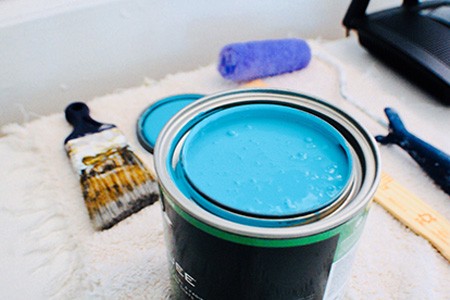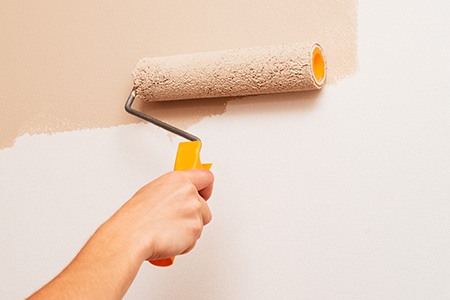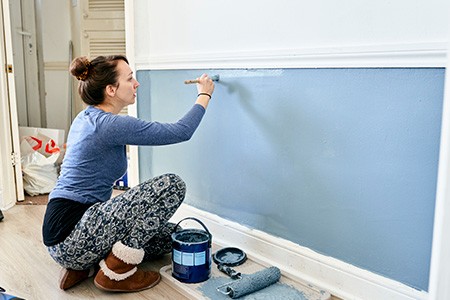Does Paint Dry Darker or Lighter? (6 Factors)
Author: Omar Alonso | Editor: Omar Alonso
Review & Research: Jen Worst & Chris Miller

Paint is a crucial component when it comes to renovating or redecorating a space. Every step is essential for achieving the desired look, from choosing the perfect color to ensuring the paint dries evenly. But does paint dry darker or lighter than you expect?
One question often arises during the painting process is whether paint dries darker or lighter. This is a common concern because the color of the paint when wet may look different from the color when it's dry.
In this blog, we will explore the factors that can influence the drying process and how they can impact the final color of the paint. Whether you're an experienced DIY-er or a beginner, this article will provide valuable insights into the paint drying process and help you achieve the desired color for your next project.
Understanding Paint Colors

Does paint darken as it dries? It’s common for the paint to dry darker, especially in the case of oil, acrylic, and latex paints. This does not necessarily mean that the final color will look different from the paint swatch used for selection. If the paint is mixed correctly, the dried paint should match the color selected from the swatch.
The drying process of paints involves the evaporation of solvents and the formation of a solid film on the surface. Several factors can affect the paint's final color, including the paint type, surface material, lighting conditions, and thickness of the application.
6 Factors Affecting Paint Color When It Dries
The type of paint, the lighting conditions, and temperature are just some of the factors than can affect the final result. We’ll describe all of them in detail.
Types of Paint

The types of paint used can affect the final color of the paint when it dries. There are two main types of paint: oil-based and water-based. Each type of paint has unique characteristics that can impact the final color.
Oil-based paints tend to dry darker than water-based paints, as they have a higher viscosity and a slower drying time. This allows the pigments to settle and form a denser, darker film on the surface. Additionally, oil-based paints can turn yellow over time, which can also affect the final color.
On the other hand, water-based paints tend to dry lighter than oil-based paints, as they have a lower viscosity and quicker drying time. They also tend to have better color stability, which means the color won't change or fade over time. So does paint dry darker or lighter? We've already established that both can be the case.
Surface Material
The surface material can also affect the final color of the paint. Different surface materials have other properties, such as texture, porosity, and color, that can alter the perception of paint color.
Does paint get darker as it dries? The surface you're painting can cause this to be the case. For example, darker surfaces, such as dark wood or brick, can absorb more light and make the paint appear darker. Lighter surfaces, such as white walls or primed drywall, can reflect light and make the paint appear lighter.
Porous surfaces, such as unprimed drywall, can also affect the final color of the paint, as the pigments can penetrate the surface and be absorbed, resulting in a darker, deeper color.
Lighting Conditions
Lighting conditions can affect the color of paint when it dries. The same paint color can appear differently under different lighting conditions, such as natural and artificial light. This is because various light sources have different spectrums and intensities, which can alter the perception of color.
For example, natural light is often cooler and bluer in the morning and afternoon and warmer and more orange in the late afternoon and evening. Artificial light can also vary, with some light sources having a yellow or green cast, while others may be closer to daylight. This is part of the conversation around daylight vs. soft white in living rooms, for example.
Thickness of Application

The thickness of the paint application can also affect the final color. Applying too thickly can result in a darker, deeper color, as the excess paint forms a denser film on the surface.
However, this also means that the paint takes longer to dry and can lead to issues with cracking or bubbling. On the other hand, applying paint too thinly can result in a lighter, more transparent color, as there is less paint to absorb light.
Additionally, the number of coats applied can also affect the final color. Multiple coats of paint can build up to form a denser, darker film, while a single coat of paint will result in a lighter, more transparent color. So does paint get lighter when it dries? Yes, which is why we nearly always need at least two coats.
Temperature
Does paint dry darker or lighter? It can, and this is a leading cause. Temperature can affect the color of the paint when it dries. Extremely high or low temperatures can cause the paint to dry too quickly or slowly, resulting in a different shade or tone than what was intended.
Additionally, temperature changes can cause the paint to crack or peel, affecting the final appearance. To ensure the best color results, it’s recommended to paint in a controlled environment within the ideal temperature range for the specific type of paint being used.
Humidity
Humidity can affect the color of the paint as it dries because high humidity levels can cause the paint to dry slower, leading to an uneven color. When the paint dries too slowly, the pigments can settle or separate, resulting in an inconsistent color or a blotchy appearance.
In addition, high humidity can also cause the paint to remain tacky or sticky, making it prone to attracting dirt and dust, which can also affect the final color.
It's important to keep humidity levels in mind when painting and follow the recommended drying times for the specific type of paint being used. Does paint dry lighter or darker due to humidity? It's more like you can get an inconsistent color that has patches of dark and patches of light.
Additionally, it's best to paint in as consistent and controlled conditions as possible to minimize the risk of color variation due to external factors such as humidity.
What Types of Paint Dry the Fastest?
Quick-drying paints, such as oil-based enamels and spray paints, generally dry the fastest. Water-based latex paints can take longer to dry and cure, while alkyd-based paints dry faster but take longer to cure. The type of paint also depends on the surface, the thickness of the paint and the humidity levels.
Understanding Paint Color Swatches

Paint color swatches are small samples of paint used to give an idea of what the final color will look like. They are a helpful tool when choosing a paint color, but it’s important to understand that they may only sometimes be reliable.
The color on the swatch may look different in different lighting conditions or on other surfaces. To use paint color swatches effectively, it’s best to compare them in the room where the paint will be used and to test the actual paint on a small area before committing to a large area. This is particularly important in scenarios like choosing the best paint colors for east-facing rooms where you're trying to be very precise.
Tips for Choosing Paint Color
To help you better understand paint colors, here are some tips to help you choose the right one for your next project:
Consider the Lighting
The way light affects a room can change the perception of color. Natural light is different from artificial light, and the time of day and direction of the windows can also play a role. Choosing what color to paint a basement ceiling is different from the best paint colors for a closet, for instance.
Consider testing paint samples in the room at different times of the day to get an accurate idea of how the color will look, especially if the room receives a lot of sunlight.
Think About the Room's Purpose
The intended use of whatever types of rooms you’re painting can influence the color you choose. For example, a bedroom is typically a calm and relaxing space, so soft blues or greens might be a good choice. On the other hand, a kitchen is often a more active space, so brighter colors work better.
Match With Existing Elements

Consider the existing elements in the room, such as flooring, furniture, and accessories, when choosing a paint color. You want to choose a color that complements and enhances these elements rather than detracts from them.
Get Paint Samples
Getting paint samples before committing to a full-scale paint job is always a good idea. You can test the color on your wall and see how it looks in different lighting conditions.
Does Paint Dry Darker or Lighter? Both & Neither!
Is paint lighter or darker when it dries? The final color of paint when it dries is determined by several factors, including the type of paint, surface material, lighting conditions, thickness of the application, temperature, and humidity. Understanding these factors can help you make an informed decision when choosing a paint color and ensure that the final result meets your expectations.
Just remember: before starting a paint project, it's always a good idea to test the color on a small area to better understand how it will look when it dries. Because the answer to does paint dry darker or lighter is yes, there's many factors that influence the final color.



